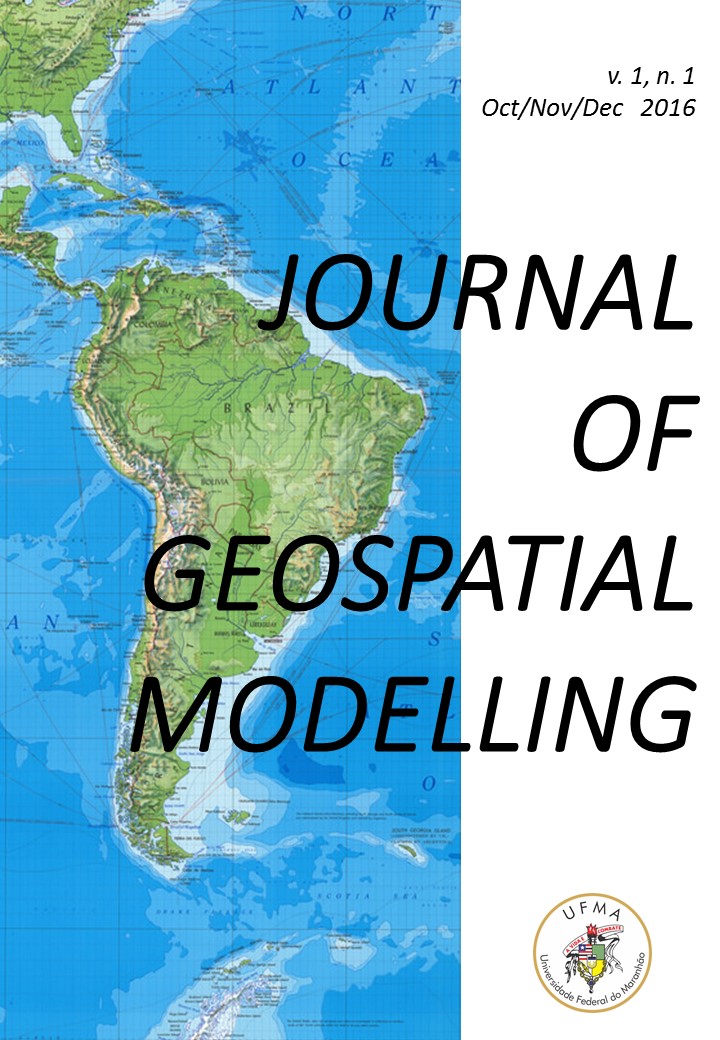CONSIDERATIONS OVER THE BIOGEOGRAPHY OF THE WEST MESOREGION OF MARANHÃO (BRAZIL)
DOI:
https://doi.org/10.22615/jgm-1.1-5813Keywords:
Eastern Amazon, Environmental conservation, Geographical areasAbstract
Abstract
The State of Maranhão has been presenting worrying data regarding the preservation of their ecosystems, being needed a greater knowledge of the State geographical space so that the mitigate measures of the environmental impacts may be adopted. Among the State mesoregions with the highest growth rate (average of 35% in the last 10 years), stands out to the west, located in the eastern Amazon. The mesoregion is formed by the union of 52 cities grouped into three microregions (Gurupi, Imperatriz, and Pindaré). The present article aims to study the main aspects of Biogeography of the Maranhão western region. The economy is based on maize, rice, babassu coconut extract, manioc, beef cattle that has been growing considerably in the recent years and still has great opportunities for investors in the mining sector. The area presents great biological diversity due to the presence of dense Rainforest, Cerrado domain and pioneer formations, which has been suffering deforestation and loss up to 70% of primitive vegetation. It
has distinct geological structures, crystalline and sedimentary, with soils that present several characteristics highly weathered. The climate presents humid tropical and equatorial features and stands out for having a transition between the humid climate of the Amazon and the semi-arid of the Brazilian northeastern. The relief is divided into two areas: the one from the Center-North, comprised of plain relief and from the Center-South, which corresponds to a
prolongation of the Brazilian central plateau. Biologically, this region houses the Biological Reserve of Gurupi (REBIO
GURUPI), which presents great importance for the conservation of the Maranhense Amazon whose ecological and environmental importance contrasts with the intense dynamics of the human occupation.
Keywords: Eastern Amazon. Environmental conservation. Geographical areas.
CONSIDERAÇÕES SOBRE A BIOGEOGRAFIA DA MESORREGIÃO OESTE MARANHENSE (BRASIL)
Resumo
O Estado do Maranhão vem apresentando dados preocupantes quanto à preservação de seus ecossistemas,
sendo necessário um maior conhecimento do espaço geográfico do Estado para que medidas mitigatórias possam ser tomadas. Dentre as mesorregiões do Estado com maior taxa de crescimento (média de 35% nos últimos 10 anos),
destaca-se a oeste, localizada na Amazônia Oriental. A mesorregião é formada pela união de 52 municípios agrupados em três microrregiões (Gurupi, Imperatriz e Pindaré). O presente artigo objetiva estudar os principais aspectos da Biogeografia da mesorregião Oeste Maranhense. A economia baseia-se nas culturas de milho, arroz, extração do coco babaçu, mandioca, pecuária de corte que vem crescendo consideravelmente nos últimos anos e ainda possui grandes oportunidades para investidores no segmento de mineração. A área apresenta grande diversidade biológica devido à presença da Floresta Ombrófila Densa, domínio de cerrado e formações pioneiras, que vem sofrendo desmatamento e perdas de até 70% da vegetação primitiva. Possui estruturas geológicas distintas, cristalinas e sedimentares, com solos que apresentam características diversas altamente intemperizados. O clima apresenta características tropicais úmidas e equatoriais e destaca-se por haver uma transição entre o clima úmido da Amazônia e o semi-árido do nordeste brasileiro. O relevo está dividido em duas áreas: a do centro-norte, formada por relevo de planície e as do centro-sul, que correspondem a um prolongamento do planalto central brasileiro. Biologicamente, essa região abriga a Reserva Biológica do Gurupi (REBIO GURUPI) que apresenta grande importância para a conservação ambiental da Amazônia Maranhense e cuja importância ecológica e ambiental contrasta com a intensa dinâmica de ocupação humana.
Palavras-chave: Amazônia oriental. Conservação ambiental. Áreas geográficas.
Downloads
Downloads
Published
How to Cite
Issue
Section
License
Copyright (c) 2016 Journal of Geospatial Modelling

This work is licensed under a Creative Commons Attribution 4.0 International License.


